boy of Faiyum pop-up card construction'
Skip the words, they're for people who actually want to make a card.
Skip the words, they're for people who actually want to make a card.
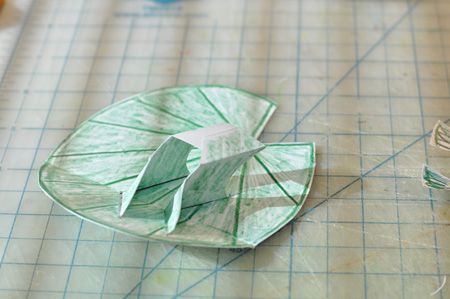 Two posts on a leaf with tabs on top that are connected to each other to form a table to hold a frog . Due to the movement of the posts working in tandem, the frog will extend beyond the edge of the leaf when the card is opened but tuck back in within the dimensions of the leaf when the card is closed. Later the leaf will also be attached with similar posts to the front of its page in the same way the frog is attached to the leaf. It will be set along the central fold at the edge of the card and it too will project forward and then tuck back to within the dimensions of the card. So, two forward motions, one surface stacked on the other. Additionally, There will be two frogs on separate leaves jumping in opposite directions. These two actions, actually two double actions the lotus leaves and the frogs, is what makes this page so darn dramatic. Essentially, it is four individual mechanisms via eight posts. |
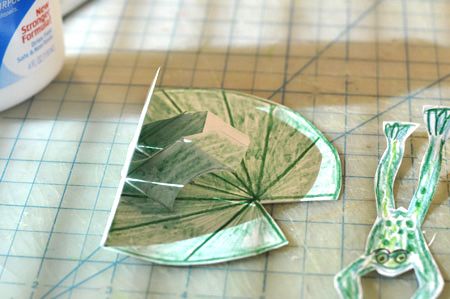 Size test. The frog must fit on its little table within the leaf when the leaf is closed At least the front edge must. Front edge alignment is of paramount importance, the rest not nearly so. An arm or leg can be cut off and repositioned if that is what it takes to get it to fit on the tiny table formed by the upper tabs of the two posts. |
 |
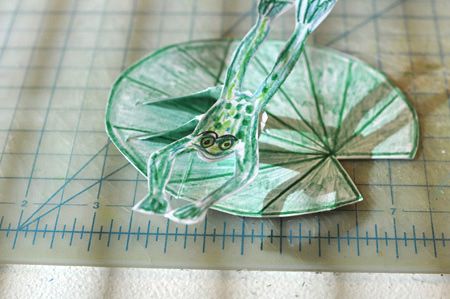 Due to the angle of the parallel posts the frog leaps forward when the leaf is opened. The leaf will work as an elevated face of the card so when the card is opened, the leaf is opened too. The leaf is forced open because it is attached to the card with posts similar to the posts that attach the frog to the leaf. Actually, the frog can be considered as half a page of yet another elevated surface of the card. The frog is only using one side of both its two posts. That allows the frog to be positioned on its table to appear as if it were leaping off at an angle toward the viewer instead of straight toward the viewer. Notice the crease in the leaf. The left half of both posts were severely trimmed because that side of the crease is not used to support the table upon which the frog is glued, although its bottom portion is still needed for the post to work. Here's another way to visualize what's going on: there are three surfaces; the card, the leaf, the frog. All three surfaces work in unison due to the posts that separate them, lift them, and arc them toward the viewer. (Another shorter set arcs away from the viewer) In this case, the top layer is different in that the top layer is formed by the tabs which are usually glued to a table are instead glued together to form a tiny table upon which a frog is glued. The frog is small enough to not require the entire surface of the post so half of their tops are removed and the frog glued at an angle. |
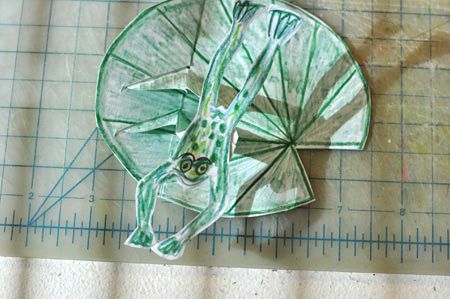 The crease in the posts must align with the crease in the leaf and with the crease in the card in order for the posts to work. This photo shows more clearly how the frog is using just one side of those two posts for its table. It needn't be this way. The table could span both side of both posts, in that case the surface of the table could then be used to force yet more mechanical devices. In this case one side of the two posts will act merely as a table, but one that arcs forward via motion of the posts when the card is opened. |
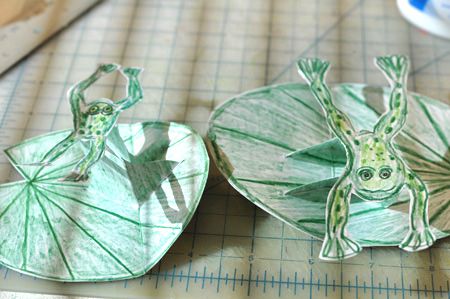 There are two projecting mechanical leaves and two tables with two projecting frogs. They will both be set along the central fold of the page but in opposite directions. One frog is positioned to appear to leap toward the viewer and the other is positioned to appear to leap away from the viewer. It does not matter which one jumps toward the viewer. Both frogs are placed to the right of the crease on their leaf so they'll be offset to each other in relation to the central fold of the page. That way the whole thing doesn't look so perfectly symmetrical and the two frogs will not interfere with each other when the card is closed. |
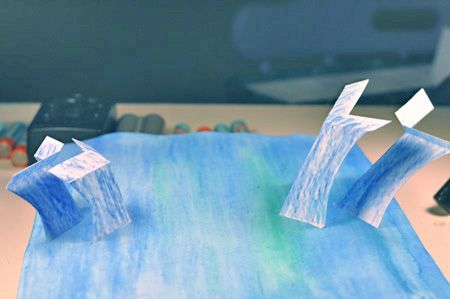 These are the posts to carry the mechanical leaves. They are not identical pairs but each pair is the same general size and the same shape but not the same length. Each pair is as parallel as possible, I dare say perfectly parallel. The central fold of all four posts is aligned with the central fold of the page. Tabs for the posts are fitted through slots cut in the background and glued to the back of the page. Which would cause an examiner to wonder just how the heck those posts stay on. The background was prepared with watercolor and a broad brush. I'm becoming very impatient with backgrounds these days. I don't care for spending much time with them. All the backgrounds were done wet with fast broad strokes, mostly to dispense with them quickly. |
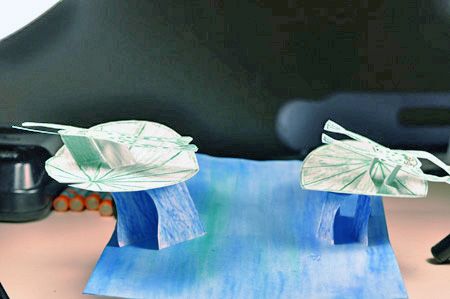 The leaves with the frogs are attached to their posts in such a way as to keep the posts parallel with each other so that they cantilever the leaf beyond the edge of the page and then tuck back into the card and folding flat without interfering with each other. This is the trick about pop-ups; getting them to do something is one thing but getting them to close is another. Obviously they must be built so that they close with all the content neatly tucked. Notice that one set of posts is taller than the other set. That is so that they will close without banging into each other. Plus the leaf surfaces can be elaborated and then slide past each other. |
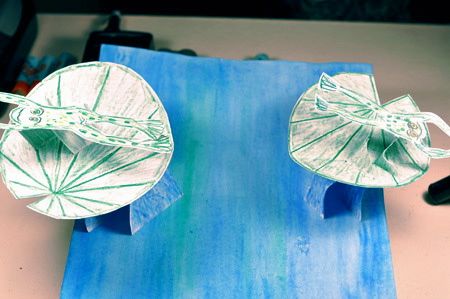 There is a lot of empty space there, and it is space that is needed for the leaves to tuck when the card is closed. Watch how that empty area is filled with content that slides past each other without interfering with card tuckage. This is possible because the two leaves, folding tables themselves, are built far enough apart and at different heights. |
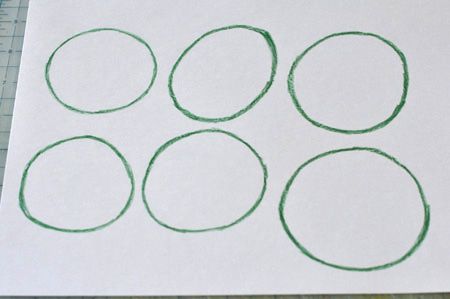 Two pages of circles and ovals like this were drawn. |
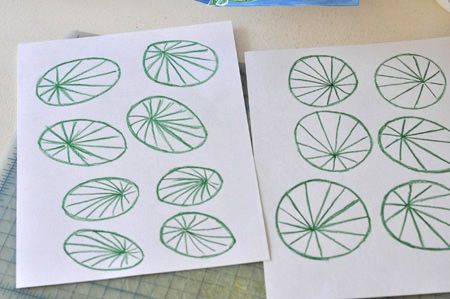 |
 Again with the watercolor area fill. I couldn't bear filling in all those leaves with coloring pencils. Watercolor is a lot messier but it's worth it. |
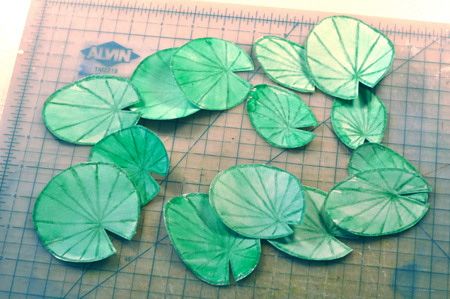 |
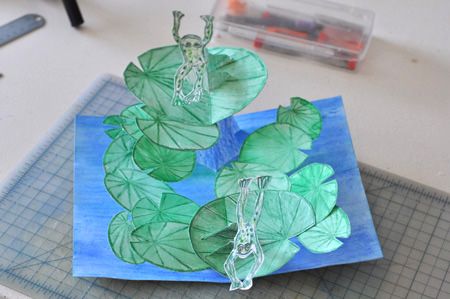 The new leaves are attached randomly to the mechanical leaves set on posts. It is possible to build them out toward the edges, checking constantly that the page still closes without the new leaves projecting beyond the edge of the card or banging into the opposite set of posts. The extensions of leaves are sufficiently stiff to not require support posts of their own. If extra support posts were needed, they would be attached to the bottom layer, and the top layer would be allowed to bend and to slide across the top of the supported layer. But that turned out to be unnecessary. |
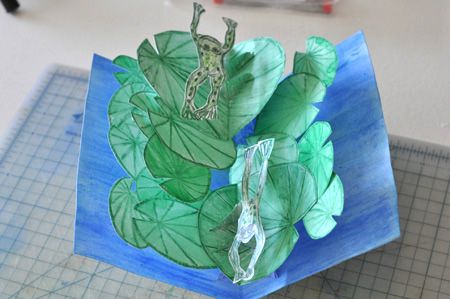 Eventually the available space is maxed out for the amount of additional lotus leaves that can be attached to the two working lotus leaf tables. A check is made to assure the page still closes. As the frog leaps outward, the leaf that it apparently jumps off (but really doesn't) also moves in that direction and drags its train of lotus leaves along with it. Two masses of lotus leaves, two extended tables, move past each other in opposite directions, one slightly above the other. When this page is opened, the whole surface moves in opposite directions beyond the dimensions of the blue background. This page alone would make a very pleasing card. But wait! There's more. |
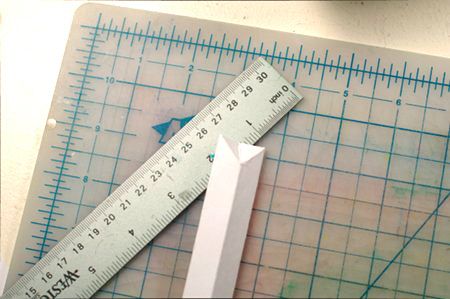 This is the main mechanism upon which the 'boy catching a frog' page is constructed. It is a crimp in the corner of a square tube. There are two such tubes and crimps. One for the boy's arm holding the frog-catching net and another crimped tube for a frog jumping off the page. The tube with a crimp for the boy's arm is stacked upon another square tube without a crimp. The surface on which the boy is drawn is twice as high as the surface from which the frog jumps. These square tubes are aligned parallel with the central fold of the page. The boy and the frog are both on the right side of the central fold. The left side of the central fold is filled with other marshland type content. |
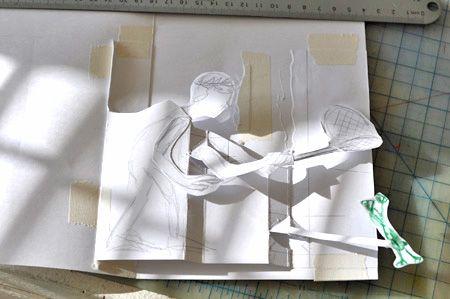 This is a prototype with masking tape. The card is fully opened. It shows a boy catching a frog with a net. The frog is jumping off the edge of the page. The boy's arm is an extension attached to one half of the 90° crimp made in the corner of the tube supporting the boy's surface. The frog is attached in a manner similar to the boy's arm. You can see the surfaces stair step up to create planes for the swinging motion of the arms. The leading edge of the flat surface is attached to the opposite side of the card on the other side of the fold. That is how this page works. If the edge of the surface that the boy is drawn were attached to his own half of the folded card, then nothing would happen when the card is opened. By attaching it to the opposite side of the central fold, then, the force of opening the card is used to drag all the attached surfaces and it pulls the square tubes effectively flattening the the tubes in the opposite direction that they were flattened when the page is closed. This creates a measureable movement precisely double the width of the square tube. The crimp in the tube starts out fully crimped with an arm attached to one surface inside the crimp (so there is a mere 45° of a 90° crimp to glue an arm, the crimp is half crimped when the card is half opened, then fully flattened like a normal uncrimped tube when the card is fully opened. the movement of the crimp creates movement in the arm that is attached to a segment of the crimp. The arm swings by 90°, which in pop-up terms is a very decent movement indeed. All sorts of things can be done with movement like that. The crimp need not be in a tube. It is possible to do that same thing within the stair itself without a tube, but using a square tube is my sytlistic choice in the manner of gluing the surfaces. |
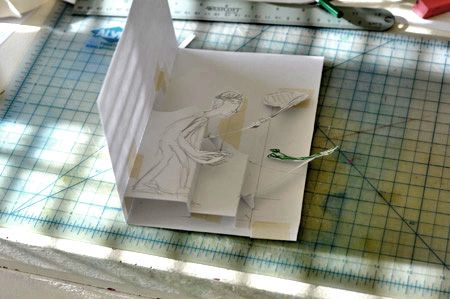 The frog and the net must fit in within the page when it is closed. It would be kind of neato if they would go off the page when the card is opened. Their movement must not interfere with each other or with the content of the page. Adjustments are made; the position and angle of the boy's hand, the length of the pole of the net, the angle of the frog on its lever, the size of the boy, bend of the body, distance from the crease, etc. |
 The leaping frog must fit for the card to acquit! |
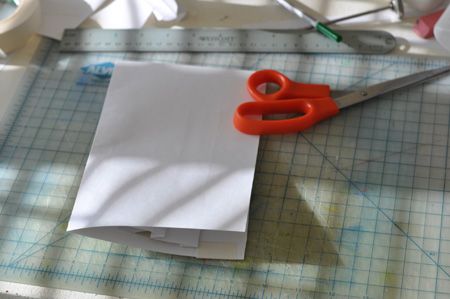 The page closes, its content tucks. |
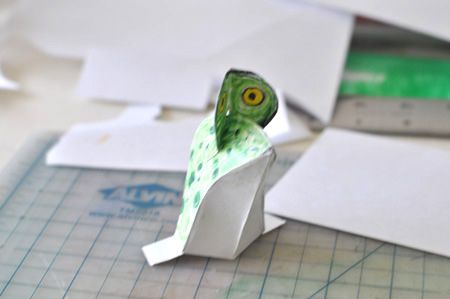 This is where I was torn between several worlds. I had competing ideas to continue. One idea is to show the boy with a bunch of frogs and then a final page with the boy at a sort of lemonade stand except his would be a fried frog's legs stand. The thing is, I've been using that 'subject becomes food' theme a lot lately and I didn't want to overdo it. Further I didn't know if I should write the boy's kiosk sign advertising his fried frog's legs in Egyptian hieroglyphics or in Latin. I'm still not sure about that. What language did the Egyptians nobles of the Roman era speak anyway? I do not know. I'm fairly sure they spoke Egyptian, but then again it was the Roman era, they most likely spoke both at least. That is what makes sense to me. It would have to be in English too or else the joke would be lost. Finally I decided to just wrap it up and show the boy's hand presenting the frog as if he were offering a gift, a birthday gift. That also made it easier for me to execute -- a frog on a table mechanism in the shape of a boy's hand. Simple. The frog could even be 2-dimensional if I wanted. But instead I decided to puff out the frog. That was the challenge here. Some seven prototypes of this frog were made. Five used a different mechanism for the eyes. Finally, I decided to attach the eyes to the top of the head as goggles, or as a human might flip their sunglasses on their head. |
 Originally, the frog had a lower jaw. I made several prototypes of frog jaws. They were all unsatisfactory. Finally, I remembered being fascinated by the frogs I caught when I myself was a boy. I recall examining their jaws with no small sense of wonder. Their bottom jaw is flat, although some could bulge out like a bubble. The skin seemed ridiculously thin and delicate. Remembering that made the whole frog jaw thing much easier to execute. This would require about twenty tiny paper hinges that followed the curve of the frog's upper mouth and front of its body. When the frog is flattened, the bottom jaw and front of its body flattens too in the opposite direction and along its own central fold but in accordance to the shape that the hinges force. The frog is attached to the boy's hand by two tabs that are pushed through slots and glued to the underside of the hand. When the hand closes, the frog collapses. Its little goggle eyes fold too. |
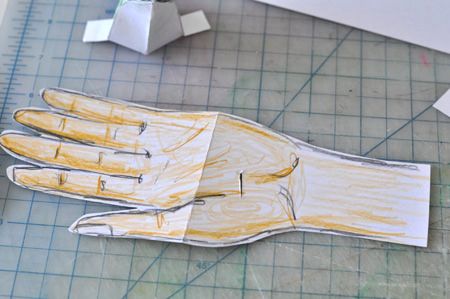 The slots in the hand are not parallel to the central fold of the hand or to the page. They are at an angle, but they are symmetrical to each other by angle and they are the same distance from the fold. The distance of the slots from each other is what creates the shape of the frog. The placement of the slots is paramount to the frog working properly. |
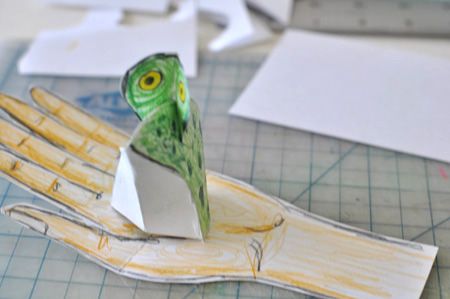 Frog body attached to the hand. It's a tight fit. |
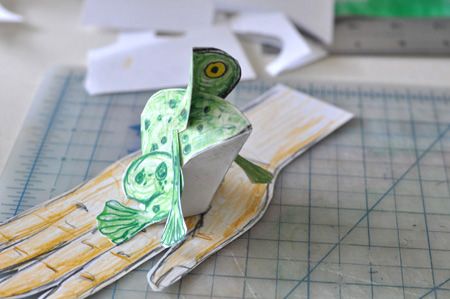 Frog legs attached to frog. Hahaha. Frog legs. |
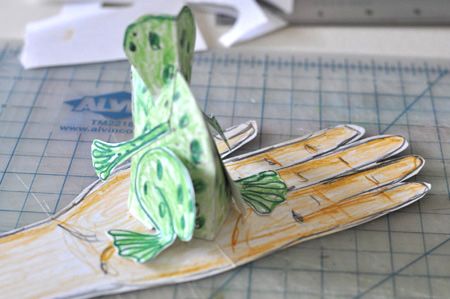 |
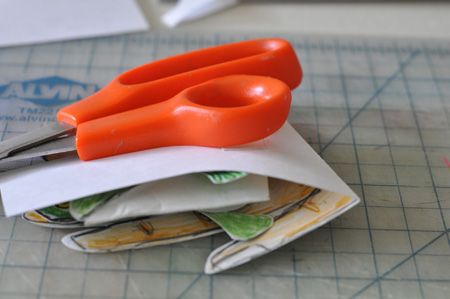 Frog inside the closed hand collapse check. |
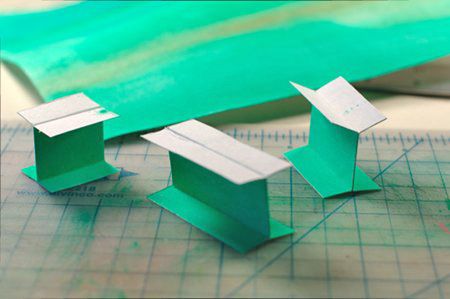 These are paper I-beams to support the hand. They were constructed from card stock watercolored to match the background. They were made from indiscriminately long strips then cut to the size needed to fit the hand. I ended up with much more I-beam footage than needed but it sure beats making them individually. The advantage is that they are reliably all the same height. Which is important for the table to work |
 This shows how the table is attached, center first. Next the right post is smashed down flat with its tabs in position for glue, then the center is smashed flat to the right so that the boy's wrist gets glued to its I-beam in the flattened to the right position. Next, the same action is done on the left. The left post is smashed down to extreme left, its tabs set for glue, then the whole hand shifted to extreme left and flattened so that the fingers get glued to their tabs. Then the hand can be pulled left to right and back and forth to extreme right and left positions and all three I-beams work together in unison. When the card is closed, all the posts conform the movement of the page by being forced, so that when the page is opened again it tends to open with the table straight up and down, and by opening, the tabs on the frog in their slots and attached to either side of the crease tug open the frog as well to the position established earlier and fixed by the tabs, a movement that simultaneously lifts and expands the frog's eyes which is the culmination of the entire card, the single goofy frog looks straight at you presented by the boy on the cover. Incidentally, today I got in the mail a children's book with eight simple pop-up mechanisms, much more simple than all this here. The tabs on those mechanisms were just glued directly onto the top surfaces for God and everybody and all the litte children to see. Their design did not call for the tabs to be fit through sloths or concealed underneath backgrounds or behind content. And I'm all, "Get you." |
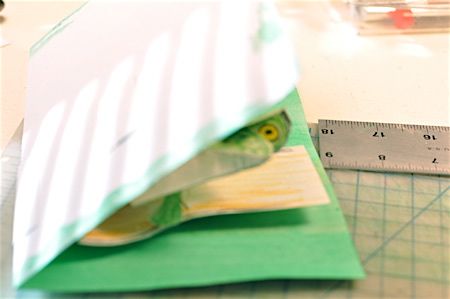 The hand too must fit. And if the hand doesn't fit, then the wrist and a few fingertips must be trimmed. In this case, all that was anticipated. |
No comments:
Post a Comment